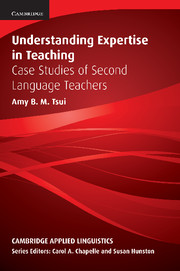Book contents
- Frontmatter
- Contents
- Series Editors' Preface
- Acknowledgments
- Chapter 1 Introduction
- Chapter 2 Conceptions of Expertise
- Chapter 3 Characteristics of Expert and Novice Teachers
- Chapter 4 Teacher Knowledge
- Chapter 5 The Case Studies
- Chapter 6 The Professional Development of the ESL Teachers
- Chapter 7 Teacher Knowledge and Managing the Classroom for ESL Learning
- Chapter 8 Teacher Knowledge and the Enactment of the ESL Curriculum
- Chapter 9 Taking on the Challenge: Exploring Process Writing
- Chapter 10 Understanding Expertise in Teaching
- Appendix 1 Reader's Comment Form on First Draft for the Second Writing Task (Angel's First Draft)
- Appendix 2 Learner Training in Making Revisions
- References
- Index
Chapter 10 - Understanding Expertise in Teaching
Published online by Cambridge University Press: 05 October 2012
- Frontmatter
- Contents
- Series Editors' Preface
- Acknowledgments
- Chapter 1 Introduction
- Chapter 2 Conceptions of Expertise
- Chapter 3 Characteristics of Expert and Novice Teachers
- Chapter 4 Teacher Knowledge
- Chapter 5 The Case Studies
- Chapter 6 The Professional Development of the ESL Teachers
- Chapter 7 Teacher Knowledge and Managing the Classroom for ESL Learning
- Chapter 8 Teacher Knowledge and the Enactment of the ESL Curriculum
- Chapter 9 Taking on the Challenge: Exploring Process Writing
- Chapter 10 Understanding Expertise in Teaching
- Appendix 1 Reader's Comment Form on First Draft for the Second Writing Task (Angel's First Draft)
- Appendix 2 Learner Training in Making Revisions
- References
- Index
Summary
In this concluding chapter I shall come back to the three questions that guided the case studies of these four ESL teachers: What are the critical differences among expert, experienced, and novice teachers? How does a teacher become an expert teacher? What are the critical factors that shaped the development of expertise?
From the accounts of the four ESL teachers in Chapters 6 to 9, we can see a number of differences between the expert teacher and the novice teacher, many of which have been documented in novice-expert studies. For example, compared to the novice teacher, Genie, the expert teacher, Marina, conducts lessons with much more fluidity and automaticity. She knows the students much better and has a much better rapport with them. She is also more selective in attending to noises and disruptions in the classroom. The question that I wish to address, however, is not what the differences between an expert teacher and a novice teacher are, but rather which of the differences are critical; critical in the sense that they are important indicators of expertise and not just experience. I shall argue that the critical differences lie in the way knowledge is developed and held by these teachers. This observation is based on the premise that knowledge is “constituted in the settings of practice” (Lave, 1988, p. 14). In other words, the specific context in which the teacher operates and the ways in which the teacher relates to the context jointly constitute the ways in which the teacher makes sense of his or her work as a teacher.
- Type
- Chapter
- Information
- Understanding Expertise in TeachingCase Studies of Second Language Teachers, pp. 245 - 282Publisher: Cambridge University PressPrint publication year: 2003



